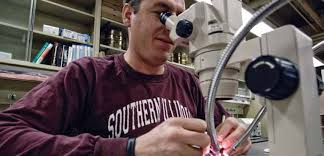
Eighth in a series on why U.S. Universities are great
Pragmatism in U.S. higher education calls for faculty and students to address real problems. Paul Simon, former Illinois Senator and presidential candidate, told me he viewed the Paul Simon Public Policy Institute as a “do” tank rather than a “think” tank. This articulates a pervasive strength of U.S. higher education: Innovation gives birth to public benefit through action.
The consequence of American research universities in shaping advances in practical applications of knowledge and insight is real. Human and technical progress is the “proof of the pudding.” Unfortunately, research institutions only serve about 30% of the student population. All types of post secondary institutions should address the value of practically applicable skills to create informed citizens and able workers in areas of critical need. Michael Crow and Christopher Tucker made this case in a 1999 reflection on research universities, The American Research University System as America’s de facto Technology Policy.
However, regional universities, those committed to baccalaureate and master’s study –typically conducting limited research — serve the majority of students in U.S. higher education.
Lacking the attractive presence of abundant academic and scientific research and creative work, nationally known intercollegiate athletics programs, and high-profile community outreach available at major research universities and state flagships, regional institutions suffer first, and most, when state funding shrinks — a death spiral. New America’s Iris Palmer says that regional institutions can no longer work to “emulate” research flagships and must define mission to be responsive to the general educational needs of students and segments of the employment market that are distinctive. Larger institutions may be able to be “everything to everybody,” but smaller campuses cannot bear that burden.
In Illinois, some regional universities are experiencing enrollment declines. State funding reductions follow. Western Illinois University, Eastern Illinois University, and Chicago State University are particularly hard hit. WIU has already laid-off over 150 staff including faculty. A clear focus on distinctive degree programs might provide an avenue to sustenance. Research universities are not free of challenges: Some experience enrollment and “student interest” deficits. Workforce pragmatics and job placement should not be the only variable in the equation but each deserves careful attention in a mercurial marketplace. Articulated focus does not necessarily lead to neglect of the liberal arts-empowered critical thinking and other broadly based skills. That argument is a straw man. Tradition rather than responsiveness to a changing environment is “ruling the roost” according to Jayson Boyers, President of Cleary University, and the cost is high. Relentless and distinctive focus may mean survival in a morphing market.
The State University of New York and the Rockefeller Institute produced an analysis addressing the importance of applied programs for New York’s state universities. Nancy Zimpher, Chancellor of the SUNY System, believes every student at every university in the System should have access to “work-based activities, co-ops, internships, work study, and clinical placement.”
Students in the various SUNY Applied Learning Programs appear satisfied with the experiences afforded them according to a Hezel Associates, LLC study testing the effectiveness of the “work based” ALP initiative.
These ideas are not new to higher education. The German Polytechnics, under the leadership of Wilhelm von Humboldt’s University of Berlin in 1810, made a strong commitment to the university providing research and applications skills demanded by the manufacturing needs of Germany and the rapidly industrializing world.
The shift from manufacturing-based economy in the 19th century to knowledge-based economies in the late 20th and 21st century requires a different perspective of university roles related to economic and technical progress. Informed leadership should balance the needs of a sound general education for individuals and work force skills and abilities that empower the national economy. Meaningful employment follows. A National Research Council analysis of 21st century manufacturing provides insight regarding the changing nature of the university’s role in producing a viable national workforce.
Distributed research and applications learning has value. The challenge entails a fresh look at the role of every university type in the constellation of U.S. institutions. The ability “to do” must be unapologetically near the nucleus of institutional mission regardless of classification, and coupled with the ability “to think.” One or the other is a 19th century throwback.
Continued leadership by U.S. universities demands this “to do” commitment and our economic future depends on it.
Photo Credit: vcresearch.siu.edu
